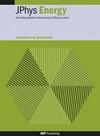Benchmark thermodynamic analysis of methylammonium lead iodide decomposition from first principles
IF 6.3
3区 材料科学
Q1 ENERGY & FUELS
引用次数: 0
Abstract
Hybrid organic–inorganic perovskites (HOIPs) such as methylammonium lead iodide (MAPbI3) are promising candidates for use in photovoltaic cells and other semiconductor applications, but their limited chemical stability poses obstacles to their widespread use.根据第一原理对碘化甲铵铅分解进行基准热力学分析
甲基碘化铅铵(MAPbI3)等有机-无机杂化过氧化物(HOIPs)是光伏电池和其他半导体应用的理想候选材料,但其有限的化学稳定性阻碍了它们的广泛应用。建立 HOIPs 及其分解产物的有限温度和压力热力学平衡的 Ab initio 模型可以揭示其稳定性极限,并有助于制定缓解策略。在此,我们利用之前公布的实验温度-压力平衡来确定谐波近似和准谐波近似的基准,并结合针对固体 MAPbI3 中甲基铵阳离子构型自由度的简单熵校正和几种密度泛函近似来证明谐波近似和准谐波近似对 MAPbI3 分解热力学的适用性。我们发现,这些近似值连同色散校正混合密度函数 HSE06,与实验评估的 T = 326 K 和 T = 407 K 之间的平衡非常吻合,为未来对 HOIP 稳定性进行广泛的热力学评估奠定了坚实的基础。
本文章由计算机程序翻译,如有差异,请以英文原文为准。
求助全文
约1分钟内获得全文
求助全文
来源期刊

Journal of Physics-Energy
Multiple-
CiteScore
10.90
自引率
1.40%
发文量
58
期刊介绍:
The Journal of Physics-Energy is an interdisciplinary and fully open-access publication dedicated to setting the agenda for the identification and dissemination of the most exciting and significant advancements in all realms of energy-related research. Committed to the principles of open science, JPhys Energy is designed to maximize the exchange of knowledge between both established and emerging communities, thereby fostering a collaborative and inclusive environment for the advancement of energy research.
 求助内容:
求助内容: 应助结果提醒方式:
应助结果提醒方式:


